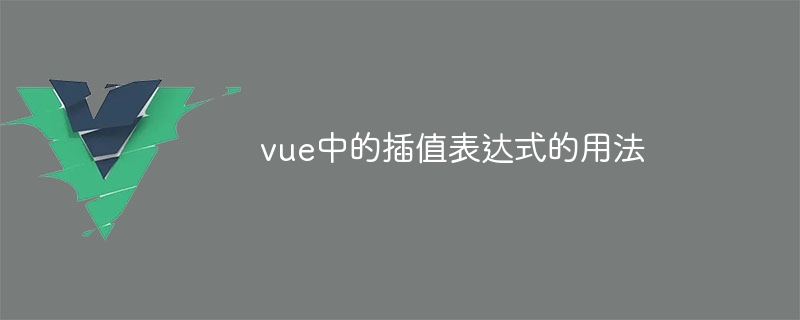How to use interpolation expressions in vue
Vue interpolation expressions are used to dynamically access data in HTML. The syntax is a pair of curly braces containing the attributes to be accessed. Interpolation expressions can be nested and used for conditional rendering, event handling and filters. Pay attention to security when using it, and encode or escape user input data to avoid malicious script code.

Usage of interpolation expressions in Vue
Interpolation expressions are used in Vue to bind data to A syntax structure for HTML templates. It allows developers to access data in Vue instances directly in HTML templates, allowing data to be dynamically displayed on the page.
Usage
Interpolation expressions are enclosed in a pair of curly braces ({}) that contain the data attribute to be accessed. For example:
<p>用户名:{{ username }}</p>In the above example, username is a data property in the Vue instance. When the Vue instance is updated, {{ username }} will be replaced with the current value of the username property.
Nested expressions
Interpolation expressions can be nested to access properties in complex data structures. For example:
<p>用户详细信息:{{ user.name }},{{ user.email }}</p>Conditional rendering
Interpolation expressions can also be used for conditional rendering, by using the v-if or v-else directive. For example:
<p v-if="user.isLoggedIn">用户已登录。</p> <p v-else>用户未登录。</p>
Event handling
Interpolation expressions can also be used in event handling, by using the v-on directive. For example:
<button v-on:click="handleUserClick">单击我</button>
Filter
Interpolation expressions also support filters, which are used to format or transform data. For example:
<p>{{ user.age | uppercase }}</p>In the above example, the uppercase filter converts the value of user.age to uppercase.
Security
You need to pay attention to security when using interpolation expressions, because they can execute malicious script code on the client side. To avoid this, user input data should always be encoded or escaped.
The above is the detailed content of How to use interpolation expressions in vue. For more information, please follow other related articles on the PHP Chinese website!

Hot AI Tools

Undresser.AI Undress
AI-powered app for creating realistic nude photos

AI Clothes Remover
Online AI tool for removing clothes from photos.

Undress AI Tool
Undress images for free

Clothoff.io
AI clothes remover

Video Face Swap
Swap faces in any video effortlessly with our completely free AI face swap tool!

Hot Article

Hot Tools

Notepad++7.3.1
Easy-to-use and free code editor

SublimeText3 Chinese version
Chinese version, very easy to use

Zend Studio 13.0.1
Powerful PHP integrated development environment

Dreamweaver CS6
Visual web development tools

SublimeText3 Mac version
God-level code editing software (SublimeText3)

Hot Topics
 How to use bootstrap in vue
Apr 07, 2025 pm 11:33 PM
How to use bootstrap in vue
Apr 07, 2025 pm 11:33 PM
Using Bootstrap in Vue.js is divided into five steps: Install Bootstrap. Import Bootstrap in main.js. Use the Bootstrap component directly in the template. Optional: Custom style. Optional: Use plug-ins.
 How to add functions to buttons for vue
Apr 08, 2025 am 08:51 AM
How to add functions to buttons for vue
Apr 08, 2025 am 08:51 AM
You can add a function to the Vue button by binding the button in the HTML template to a method. Define the method and write function logic in the Vue instance.
 How to use watch in vue
Apr 07, 2025 pm 11:36 PM
How to use watch in vue
Apr 07, 2025 pm 11:36 PM
The watch option in Vue.js allows developers to listen for changes in specific data. When the data changes, watch triggers a callback function to perform update views or other tasks. Its configuration options include immediate, which specifies whether to execute a callback immediately, and deep, which specifies whether to recursively listen to changes to objects or arrays.
 What does vue multi-page development mean?
Apr 07, 2025 pm 11:57 PM
What does vue multi-page development mean?
Apr 07, 2025 pm 11:57 PM
Vue multi-page development is a way to build applications using the Vue.js framework, where the application is divided into separate pages: Code Maintenance: Splitting the application into multiple pages can make the code easier to manage and maintain. Modularity: Each page can be used as a separate module for easy reuse and replacement. Simple routing: Navigation between pages can be managed through simple routing configuration. SEO Optimization: Each page has its own URL, which helps SEO.
 How to reference js file with vue.js
Apr 07, 2025 pm 11:27 PM
How to reference js file with vue.js
Apr 07, 2025 pm 11:27 PM
There are three ways to refer to JS files in Vue.js: directly specify the path using the <script> tag;; dynamic import using the mounted() lifecycle hook; and importing through the Vuex state management library.
 How to return to previous page by vue
Apr 07, 2025 pm 11:30 PM
How to return to previous page by vue
Apr 07, 2025 pm 11:30 PM
Vue.js has four methods to return to the previous page: $router.go(-1)$router.back() uses <router-link to="/" component window.history.back(), and the method selection depends on the scene.
 How to use vue traversal
Apr 07, 2025 pm 11:48 PM
How to use vue traversal
Apr 07, 2025 pm 11:48 PM
There are three common methods for Vue.js to traverse arrays and objects: the v-for directive is used to traverse each element and render templates; the v-bind directive can be used with v-for to dynamically set attribute values for each element; and the .map method can convert array elements into new arrays.
 How to jump to the div of vue
Apr 08, 2025 am 09:18 AM
How to jump to the div of vue
Apr 08, 2025 am 09:18 AM
There are two ways to jump div elements in Vue: use Vue Router and add router-link component. Add the @click event listener and call this.$router.push() method to jump.






